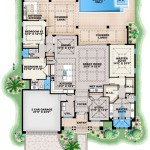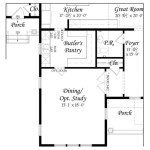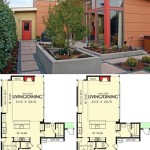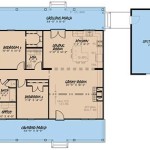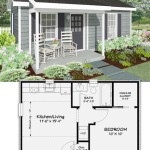1 Bedroom Apartment Floor Plans With Dimensions In Meters
The design and layout of a one-bedroom apartment significantly impact its functionality and perceived spaciousness. Understanding the dimensions, in meters, of various floor plan configurations is crucial for prospective tenants and owners. This information allows for informed decisions regarding furniture placement, storage solutions, and overall suitability to individual needs. This article explores different one-bedroom apartment floor plans, highlighting typical dimensions and key features.
Accurate measurements are essential when planning a living space. Metric measurements, specifically meters, provide a standardized and universally understood system for describing the length and width of rooms and overall apartment size. Using meters allows for ease of comparison between different floor plans and simplifies calculations for furniture and fixture placement. A floor plan expressed in square meters provides a clear understanding of the apartment's total area.
Several factors influence the overall dimensions of a one-bedroom apartment. These include geographical location, building type (e.g., high-rise, low-rise, converted house), and intended market (e.g., affordable housing, luxury apartments). Consequently, one-bedroom apartments can range considerably in size, from compact studios transformed into one-bedroom units to more generously proportioned residences.
Common One-Bedroom Apartment Layouts and Their Dimensions
One of the most prevalent layouts is the linear or rectangular configuration. This design typically features an entrance leading to a hallway, off which are the bathroom, bedroom, and an open-plan living/dining/kitchen area. In such a setup, the living area might measure approximately 4 meters by 5 meters (20 square meters), offering enough space for a sofa, coffee table, and entertainment unit. The kitchen area, often integrated into the living space, could occupy a space of 2 meters by 3 meters (6 square meters), accommodating essential appliances and countertop space. The bedroom is typically around 3 meters by 4 meters (12 square meters), allowing for a double bed, bedside tables, and a wardrobe. The bathroom usually measures 1.5 meters by 2 meters (3 square meters) incorporating the toilet, shower/bath, and sink. This layout utilizes space efficiently and is common in urban apartment buildings.
Another popular layout is the "L-shaped" design. This often involves a slightly more angular configuration, potentially offering more distinct separation between living and sleeping areas. The living area might be configured as 4.5 meters by 4 meters, while the kitchen could take up a space of 2.5 meters by 2.5 meters. The bedroom could then occupy an area of 3.5 meters by 3 meters. The L-shape can allow for more natural light penetration, especially if the apartment benefits from windows on two exterior walls. This layout often results in a small hallway or entry area, which can be useful for coat and shoe storage.
A less common but occasionally encountered layout involves a more square configuration. In this layout, the overall apartment might be close to a square, with dimensions such as 7 meters by 7 meters. The challenge then lies in effectively dividing the space. A possible configuration might allocate a 3.5 meters by 4 meters area to the living space, a 3 meters by 3 meters area to the kitchen, and a 3.5 meters by 3.5 meters area for the bedroom. This layout necessitates careful space planning to avoid making the apartment feel cramped.
The dimensions provided are representative and can vary significantly depending on the specific apartment. It is crucial to consult the official floor plan and verify measurements before making any commitments or purchasing furniture. The location of doors and windows also greatly impacts the useable floor space.
The Importance of Room Dimensions in Planning Furniture Layout
Understanding the exact dimensions of each room is vital when planning furniture placement. For example, knowing that the living room is 4 meters by 5 meters informs the selection of a sofa and coffee table. A large sectional sofa might overwhelm the space, while a smaller loveseat might be more appropriate. Similarly, the bedroom dimensions dictate the size of the bed and the feasibility of including additional furniture such as a dresser or desk.
When selecting furniture, consider leaving adequate circulation space. A minimum of 60 centimeters should be maintained around furniture to allow for comfortable movement. This means that if a bed is 2 meters long, the bedroom should be at least 2.6 meters wide to allow for comfortable walking space around the bed. Accurate measurements prevent the frustration of purchasing furniture that does not fit or makes the apartment feel cramped.
Vertical space should also be considered. In apartments with high ceilings, tall bookshelves or storage units can maximize storage capacity without significantly impacting floor space. Conversely, in apartments with low ceilings, opting for low-profile furniture can help to create a sense of spaciousness.
Considerations for Kitchen and Bathroom Dimensions
The kitchen area in a one-bedroom apartment, even when integrated into the living space, requires careful planning. Standard kitchen appliances, such as refrigerators and stoves, have fixed dimensions that must be accommodated. Countertop space is also a crucial consideration, as it directly impacts food preparation and storage. A kitchen space of 2 meters by 3 meters, as mentioned in the linear layout example, provides minimal but adequate space for essential kitchen activities. However, if extensive cooking is anticipated, a larger kitchen area might be desirable.
Bathroom dimensions are typically more standardized, but even slight variations can impact functionality. A bathroom of 1.5 meters by 2 meters provides sufficient space for a toilet, sink, and shower/bath combination. However, the placement of fixtures and the swing of the door can affect the useable space. Optimizing storage in a small bathroom is important. Wall-mounted cabinets or under-sink storage can help to declutter the space. A walk-in shower might be preferable to a bathtub for individuals with mobility issues or those who prefer the convenience of a shower.
The placement of plumbing fixtures is a significant factor in determining the layout of the kitchen and bathroom. Moving plumbing can be costly and complex, so it is important to carefully consider the existing configuration when planning renovations or furniture placement. Adhering to building codes and regulations is crucial when making any alterations to plumbing or electrical systems.
Impact of Dimensions on Storage Solutions
In a one-bedroom apartment, efficient storage solutions are paramount. Limited square footage necessitates creative approaches to maximize storage capacity. Understanding the dimensions of closets, cabinets, and other storage spaces is essential for organizing belongings effectively. Closets, for instance, might measure 1 meter by 1 meter internally, demanding organized storage systems to effectively utilize the space. Vertical storage solutions, such as shelves and drawers, are particularly useful in maximizing closet space.
Multi-functional furniture can also contribute to enhanced storage. A bed with built-in drawers, a coffee table with storage compartments, or a sofa with hidden storage are all examples of furniture that serves multiple purposes. These types of furniture are particularly valuable in small apartments where space is at a premium.
Utilizing wall space for storage is another effective strategy. Shelves can be installed in the living room, bedroom, or even the bathroom to provide additional storage for books, decorations, or toiletries. Over-the-door organizers can also be used to maximize storage space in closets or bathrooms. Good lighting is also important to optimize the usability of storage locations.
Ultimately, the dimensions of a one-bedroom apartment directly influence the choice of furniture, layout, and storage solutions. A thorough understanding of the floor plan, including accurate measurements in meters, is crucial for creating a functional and comfortable living space.

Floorplan Of One Bedroom Apartment Used As Acoustic Environment For The Scientific Diagram

Living Small With Style 2 Beautiful Apartment Plans Under 500 Square Feet 50 Meters Distribución Del Apartamento Plano De Apartamentos

M 1 Bedroom Floor Plan The Waverley Apartments

M C12 Studio 1 2 Bedroom Apartment Als River North Chicago The Bush Temple

1 Bedroom Apartment Floor Plans Leona Apartments Honeypark Dun Laoghaire Dublin

Studio 1 2 Bedroom Apartments In Pittsburgh Hot Metal Flats

1 Bedroom House Floor Plans Decide Your

Studio House Plans 6x8 Gable Roof Tiny Cottage Floor

12 Examples Of Floor Plans With Dimensions

House Plans 7x6 With One Bedroom Flat Roof Samhouseplans
Related Posts

